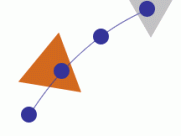Electrodes - Material and Care
There are many choices of electrode shape, size, and configuration to fit the need of the patient and therapeutic goal for electrical stimulation.
Types of Electrodes
- Metal Plate Electrodes - early version, limited sizes, required wet sponge conduction medium, difficult to secure in place
-
Carbon - Impregnated Rubber Electrodes - degrade over time and become non-uniform with "hot spots", many shapes and sizes, rinse and dry after each use and replaced every 12 months to ensure conductivity.
-
Self-Adhering or Single use Electrodes - flexible conductors, convenient application, no strapping or taping to keep in place, resealable bag for multiple uses, often high impedance, possibility of cross-contamination, used most frequently these days. Single use electrodes MAY NOT be shared between patients.
Electrode Size and Current Density
- Current density is the concentration of current under an electrodes.
- Electrode surface area is inversely proportional to current flow. (Larger electrode = current is less dense as it is distributed over a larger area; the smaller the electrode, the more intense the same current becomes over a smaller area.
- Keep the electrode in proportion with size of body area being treated. If the electrode is too large for the area, there could be unwanted carryover to other surrounding structures; if too small, the current is too dense and may not be tolerated to elicit the desired response.
Completing the Circuit - an electrical stimulation treatment must include a full circuit. To complete the circuit, there must be:
- A source of energy creating an electrical potential difference
- A conductive pathway - including electrodes, leads, and a conductive surface with good contact
- Cleaning the patient's skin with alcohol to remove oil and dirt before electrode application
- Clipping excess body hair under electrodes
- Minimize warming the treatment area of the body prior to stimulation so there is minimal increased resistance
Electrode Configuration
Monopolar - always two poles: cathode (-) is active and produces cell depolarization. Produces a net charge
Bipolar - two electrodes in a single circuit; each electrode alternates between positive and negative; electrodes are of equal size; no net charge is produced
Patient will feel excitatory response under both electrodes, eliciting motor response or electrode placed over motor point, other electrode over muscle belly and may be larger
Quadripolar - four electrodes in two circuits that operate independently, yet interact
Interferential, large area, pain management, sensory stimulation of larger fiber
Note: electrical stimulation units will call the circuits "channels"
Techniques for Application of Electrical Stimulation
|
Treatment Goal |
# Leads and Electrodes |
Monopolar |
Bipolar |
Quadpolar |
|
Muscle (motor) Stimulation |
One channel per muscle with both electrodes on the same muscle, two leads if it Is a larger muscle or if the device has more than one head
|
|
X |
|
|
Sensory Stimulation |
One or two channels depending on the size of the area; use as many electrodes as possible to achieve the desired sensory stimulation
One channel only if two electrodes fit in the treatment area
|
|
X |
X
|
|
Tissue repair |
One channel: active electrode in the treatment area and the dispersive is placed proximally to target area >12-18" away |
X |
|
|
Evidence
Evidence is emerging constantly and it is important to consider both the theoretical effects and the strength of the evidence, while keeping PICO in mind. It is a best practice to consider the patient population (P), intervention (I), comparison group (C) and outcomes (O) when making decisions about evidence-guided practice.
- TENS as part of a PT plan of care for patients post stroke can help reduce post-stroke spasticity (a condition associated with changes in neuromuscular function) https://www.ncbi.nlm.nih.gov/pubmed/30326752
- In a study of subjects with low back pain from disc herniation, TENS as a stand alone treatment for low back pain and abdominal muscle activation has been shown to be less effective than mobility training https://www.ncbi.nlm.nih.gov/pubmed/30247159
- TENS as a component of standard wound care in older adults with pressure injury has been shown to reduce pain and improve tissue healing rates https://www.ncbi.nlm.nih.gov/pubmed/30234576
- There is mixed-to-low evidence on the effectiveness of TENS in treating neuropathic pain: https://www.ncbi.nlm.nih.gov/pubmed/28905362
- NMES has shown some benefit on function in strength in persons with advanced disease:https://www.ncbi.nlm.nih.gov/pubmed/27748503
- A recent studies show that use of electrical stimulation in various forms did not result in adverse heating of medical implants: https://www.ncbi.nlm.nih.gov/pmc/articles/PMC5315240/
- A recent study supports the use of functional electrical stimulation for improving gait post-stroke: https://www.ncbi.nlm.nih.gov/pubmed/29944167
toc | return to top | previous page | next page


